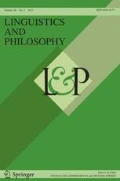Abstract
In the first part of this article, we show that, contrary to the Gricean tradition, inter-clausal and is not semantically equivalent to logical conjunction and, contrary to temporal approaches such as Bar-Levand Palacas 1980, it is not temporallyloaded. We then explore a commonsenseidea – namely that while sentence juxtaposition might be interpreted either as discourse coordination or subordination, and indicates coordination. SDRT already includes notions of coordinating and subordinating discourse relations (cf. Lascarides and Asher 1993, Asher 1993), and the meaning of and is related to this distinction. Similar distinctions that play a crucial role in anaphora resolution have also appeared in AI – cf. Scha and Polanyi 1988, or Webber 1991. However, this discourse-structure-based distinction has not been well defined yet, and our approach provides independent motivation for it. This paper argues that the semantics of and includes a notion of coordination expressed as the requirement of a Coordinated Discourse Topic (CDT).CDT characterizes aclass of discourse relations, among which are Narration and Result.Once the basic semanticcontribution of and is isolated, effects related to its presence such as changes in temporal structure, blocking of a Discourse Relation, or conditional meanings are shown to follow from the defeasiblearchitecture set up by SDRT.
Similar content being viewed by others
REFERENCES
Alves, A. and I. G. Txurruka: 2001, ‘The Meaning of Same in Anaphoric Temporal Adverbials’, in Myriam Bras and Laure Vieu (eds.), Semantic and Pragmatic Issues in Discourse and Dialogue, Amsterdam: Elsevier.
Asher, N.: 1993, Reference to Abstract Objects in Discourse, Dordrecht: Kluwer Academic Press.
Asher, N.: 1998, Common Ground, Corrections and Coordination, Austin: Draft.
Asher, N. and T. Fernando: 1997, ‘Representations with Effective Labeling for Disambiguation’, Second International Workshop on Computational Semantics, Tilburg, The Netherlands.
Asher, N. and A. Lascarides: 1998, The Semantics and Pragmatics of Presupposition, Draft.
Asher, N. and M. Morreau: 1991, ‘Commonsense Entailment: A Modal Theory of Non-monotonic Reasoning’, in Greg Carlson and Jeff Pelletier (eds.), The Generic Book, University of Chicago Press.
Austin, J. L.: 1962, How to do Things with Words, Oxford Press.
Bar-Lev, Z. and A. Palacas: 1980, ‘Semantic Command over Pragmatic Priority’, Lingua 51, 137–146.
Bergson, H.: 1940, Le rire, Paris: Presses Universitaires de France.
Blakemore, D. and R. Carston: 1999, The Pragmatics of and-Conjunctions: the Non-Narrative Cases, Draft. Published in UCL Working Papers in Linguistics 11, 1–20.
Bras, M., A. Le Draoulec and L. Vieu: 2001, ‘French Adverbial puis between Temporal and Discourse Structure’, in M. Bras and L. Vieu (eds.), Semantic and Pragmatic Issues in Discourse and Dialogue, Amsterdam: Elsevier.
Carlson, L.: 1994, Well in Dialogue Games, Amsterdam/Philadelphia: Benjamins Publishing Company.
Carston, R.: 1993, ‘Conjunction, Explanation and Relevance’, Lingua 90, 27–48.
Cohen, L. J.: 1971, ‘The Logical Particles of Natural Language’, in Y. Bar-Hillel (ed.), Pragmatics of Natural Languages, Dordrecht: Reidel, pp. 50–68.
Cohen, R.: 1983, A Computational Model for the Analysis of Arguments, Ph.D. thesis, Technical Report 151, Computer Systems Research Group, University of Toronto.
Danlos, L.: 2001, ‘Event Co-reference and Discourse Structure’, in Proceedings of ICCS-01, Donostia-San Sebastián.
Dowty, D.: 1986, ‘The Effect of Aspectual Class on the Temporal Structure of Discourse’, Linguistics and Philosophy 9, 37–61.
Gazdar, G.: 1979, Pragmatics, New York: Academic Press.
Grice, H. P.: 1975, ‘Logic and Conversation’, in P. Cole, J.L. Morgan (eds.), Syntax and Semantics, 3: Speech Acts, New York: Academic Press, pp. 41–58.
Grice, H. P.: 1989, Studies in the Way of Words, Cambridge, Massachusetts: Harvard University Press.
Grosz, B. and C. Sidner: 1986, ‘Attention, Intention and the Structure of Discourse’, Computational Linguistics 12, 175–204.
Kamp, H.: 1981, ‘A Theory of Truth and Semantic Interpretation’, In Jeroen Groenendijk et al. (eds.), Formal Methods in the Study of Language, Amsterdam: Mathematical Centre Tracts, pp. 277–322.
Kamp, H. and U. Reyle: 1993, From Discourse to Logic, Dordrecht: Kluwer Academic Publishers.
Kempson, R.: 1975, Presupposition and the Delimitation of Semantics, Cambridge: Cambridge University Press.
Kitis, E.: 1995, ‘Connectives and Ideology’, Fourth International Symposium on Critical Discourse Analysis, University of Athens.
Lascarides, A. and N. Asher: 1993, ‘Temporal Interpretation, Discourse Relations and Commonsense Entailment’, Linguistics and Philosophy 14.
Mann, B. and S. Thompson: 1986, ‘Relational Propositions in Discourse’, Technical Report RR-83-115, Information Sciences Institute, CA: Marina del Rey.
Moxey, L. and A. Sanford: 1988, ‘Quantifiers and Focus’, Journal of Semantics 5, 189–206.
Olman, L.: 1998, Evidence for Iconicity: The Instance Relation in Informational Exposition, University of Texas at Austin: MA thesis.
Pierrehumbert, J. and J. Hirschberg: 1990, ‘The Meaning of Intonational Contours in the Interpretation of Discourse’, in P. R. Cohen, J. Morgan and M. Pollack (eds.), Intentions in Communication, Cambridge: MIT Press, pp. 271–312.
Polanyi, L.: 1998, ‘A Formal Model of the Structure of Discourse’, Journal of Pragmatics 12, 601–638.
Polanyi, L.: 1999, Linguistic Discourse Structure, Draft.
Posner, R.: 1978, ‘Semantics and Pragmatics of Sentence Connectives in Natural Language’, in F. Kiefer, J. Searle (eds.), Speech Acts and Pragmatics, Amsterdam: North Holland.
Scha, R. and L. Polanyi: 1988, ‘An Augmented Context Free Grammar for Discourse’, in Proceedings of COLING, Budapest.
Schmerling, S.: 1975, ‘Asymmetric Conjunction and Rules of Conversation’, in P. Cole, J. L. Morgan (eds.), Syntax and Semantics 3: Speech Acts, New York: Academic Press, 211–232.
Searle, J. 1968, Speech Acts, Cambridge University Press.
Seville, H. and A. Ramsay: 1999, Reference-Based Discourse Structure for Reference Resolution, Manchester, England: Center for Computational Linguistics. Draft.
Walker, M. 1995. Corrections, AAAI Symposium on Computational Implicature, CA: Stanford.
Webber, B. L.: 1991, ‘Structure and Ostension in the Interpretation of Discourse Deixis’, Language and Cognitive Processes 6, 197–135.
Author information
Authors and Affiliations
Rights and permissions
About this article
Cite this article
Txurruka, I.G. The Natural Language Conjunction And . Linguistics and Philosophy 26, 255–285 (2003). https://doi.org/10.1023/A:1024117423963
Issue Date:
DOI: https://doi.org/10.1023/A:1024117423963




